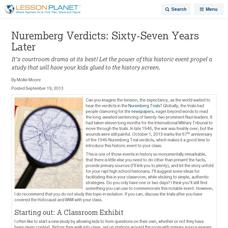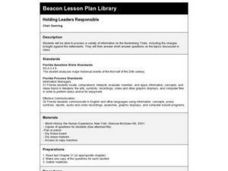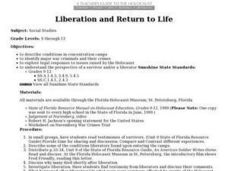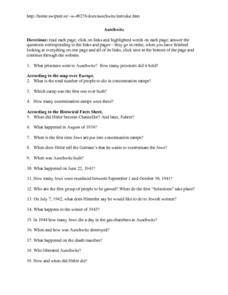Curated OER
Lessons from the Holocaust
In an ultimate lesson plan about listening to opposing points of view, your young historians read testimony from the Nuremberg Trials by Nazi SS officers regarding their actions during the Holocaust and a brief speech by Himmler to SS...
Facing History and Ourselves
Justice After the Holocaust
Though there could be no true justice for the horrors of the Holocaust, many of those responsible for crimes against humanity were found guilty in the eyes of the law. Using primary and secondary sources in the 16th installment of a...
Echoes & Reflections
Timeline of the Holocaust
An interactive timeline uses images, videos, primary source documents, and links to informational text to chronicle the history of the Holocaust from 1933-1945.
Curated OER
Nuremberg Verdicts: Sixty-Seven Years Later
It’s courtroom drama at its best! Let the power of this historic event propel a study that will have your kids glued to the history screen.
Curated OER
Nuremberg Remembered: Guilt and Responsibility
Students explore the Nuremberg trials. For this Holocaust lesson, students research the Nuremberg trials. They gather primary sources or documents to support their arguments for the charges against people examined in the trials.
Curated OER
Holding Leaders Responsible
Students research and answer questions about the Nuremberg Trials.
While They Watched
Teaching the Holocaust
What is the difference between prejudice and discrimination? Between collaborators and bystanders? Guilt and responsibility? Prompt learners to think critically about a very complex and textured topic with an innovative packet...
Echoes & Reflections
Perpetrators, Collaborators, and Bystanders
After the Holocaust, the world grappled with how to bring justice to the Nazis. But what to do with the thousands—if not millions—who allowed it to happen? Young historians consider the issues of guilt, collaboration, and responsibility...
Museum of Tolerance
Documents That Shape Society
The Bill of Rights is a foundational document of American democracy, much like the Nuremberg Laws were a foundational document of the Reichstag of Nazi Germany. But that's where their similarities end. Engage high schoolers in a...
Curated OER
A Look at Exclusion Through Improvisation
Building a realistic understanding of the trials Jews suffered during WWII isn't always easy. This plan employs student constructed dramatic freeze frame scenes to help build a deeper understanding of Jewish Ghettos, concentration camps,...
Curated OER
Coming to Terms with the Past
Students explore Holocaust survivor Simon Wiesenthal. They conduct research to examine how the post-Holocaust period has been handled historically and hold a teach-in to promote continued awareness of the Holocaust's impact.
Curated OER
The Jewish Holocaust
Ninth graders research the causes and events of the Jewish holocaust during World War II. They view a video and PowerPoint presentation and take notes, participate in a class discussion about the term "genocide," and take a quiz.
Curated OER
Liberation and Return to Life
Students read testimonies of Holocaust survivors, describe conditions liberators found upon entering camps, investigate liberation, and research background of the Office of Special Investigations and Nuremberg War Crimes Trials.
Facing History and Ourselves
Laws and the National Community
When it comes to the law, is justice always served? Teach scholars about how law sometimes enables prejudice of entire groups of people with a unit on World War II that includes a warm-up activity, analysis of primary sources,...
Curated OER
Flying Against The Wind
Eighth graders discuss the various actions of non-Jewish Germans during World War II. Through various readings and activities, they explore the rejection of Nazi ideology and how many German citizens worked to help Jewish citizens during...
Curated OER
Genocide in World War II
High schoolers access a variety of websites that explore the Nazi German genocide of Jews in WWII. They view a film, complete a worksheet and write an opinion paper supporting the view to either punish or forgive the perpetrators of...
Duke of Definition
Reading Comprehension: Auschwitz
In this reading comprehension worksheet learners are given a link that will take them to a website where they will read about Auschwitz. Students follow links on the website to find answers to comprehension questions.
Curated OER
Auschwitz
In the Auschwitz worksheet, learners respond to 36 short answer questions as they visit and research websites pertaining to the infamous concentration camp of World War II.
Curated OER
Prisoners in Another War
Learners identify violations of the Geneva Convention in video clips. They discover the role of international bodies in dealing with war crimes. They read primary source documents as well.
Yad Vashem, The World Holocaust Remembrance Center
Yad Vashem: The Nuremberg Trials
Between 1946-1949 Nazis were put on trial for the atrocities they committed. The series of trials were known as the Nuremberg Trials and showed the world the inhumane conduct by the Nazis. Study these trials by viewing documents from the...
US Holocaust Memorial Museum
U.s. Holocaust Memorial Museum: The Nuremberg Trials and Their Legacy
How do you bring justice to the millions of people killed in German concentration camps? The Nuremberg Trials attempted this challenge. Study how SS officers were put on trial and punished using the following primary sources. Included...
A&E Television
History.com: 10 Things You May Not Know About the Nuremberg Trials
The post-World War II trials marked the first-ever prosecutions for genocide and crimes against humanity. Held directly after World War II, the Nuremberg Trials were a series of 13 military tribunals in which nearly 200 German...
US Holocaust Memorial Museum
U.s. Holocaust Memorial Museum: The Nuremberg Trials and Their Legacy
A comprehensive, multimedia look at the Nuremberg Trials and their results.
University of South Florida
Fcit: A Teacher's Guide to the Holocaust
A Teacher's Guide to the Holocaust offers an overview of the people and events of the Holocaust. Extensive teacher resources and student activities are included, as well as photographs, documents, art, music, movies, literature, and more.






















